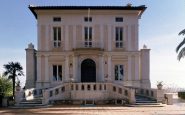« Indietro
A vent'anni dalla scomparsa di Reima Pietilä (1923-1993), Andrea Nastri pubblica una monografia sul suo contributo all'architettura del Novecento (Aracne, Roma 2012), che conferma l'attenzione della critica italiana alla figura di un maestro controverso. Abbiamo chiesto a Aino Niskanen, professore di Storia dell'Architettura alla Aalto University di Helsinki, di commentare il lavoro di Andrea Nastri, che è nato sotto la supervisione del professor Fabio Mangone dell'Università Federico II di Napoli.
Le nuove ricerche in corso sull'opera di Raili e Reima Pietilä saranno presentate in una giornata di studio sul tema 'Raili and Reima Pietilä. Unsettled Architecture' all'Accademia Nazionale di San Luca a Roma il 28 maggio prossimo (ore 16-19). La giornata sarà introdotta dal prof. Paolo Portoghesi, Presidente dell'Accademia Nazionale di San Luca.
Andrea Nastri on Pietilä : Reima Pietilä, dallo schizzo all´architettura , by Aino Niskanen
Andrea Nastri, young architect (1976) who graduated from Università Federico II in Napoli and has been involved in several research projects since, has published in 2012 a book on one of the most important characters of Nordic modernism, Reima Pietilä (1923-1993). Pietilä was from the very start of his career an experimentalist and a researcher of alternative ways of architecture. Before Nastri there has already been Italian interest in him: Bruno Zevi started to follow Pietilä´s work early and after him Manfredo Tafuri and Paolo Portoghesi. Tafuri coined Pietilä together with Jörn Utzon and Eero Saarinen into the category of “neurotic opposition of the International Style”. Two books have appeared in Italian before this: by Carmine Benincasa in 1970 and an exhibition catalogue by Torre Colombera 1997.
Nastri introduces Pietilä´s main works for the Italian audience emphasizing his experimentalism. The first chapters start with looking at Pietilä´s avant-garde position in international context and his design methodology; then follows the description of key works. Pietilä´s avant-garde roots are found in Kurt Schwitters´dadaism, Russian constructivism and German expressionism. His theory and architecture opposed the reduction to basic elements and Cartesian geometries which are closely tied to capitalist economy, says Nastri. He positions Pietilä also into the Finnish architectural scene, somewhere between the opposing ideologies of Alvar Aalto and Aulis Blomstedt. Nastri tells that Pietilä had few international contacts and does not seem to know that Pietilä was the only Finnish member of the International Team Ten; the last Team Ten meeting was even proposed to be held in Dipoli but never took place. Pietilä was very aware what happened elsewhere and in contact with the most theoretically advanced international circles of the 1960s and 1970s. Nevertheless Nastri analyzes well Pietilä´s dualistic relation towards tradition and modernity.
The chapters dedicated to Pietilä´s working method point out why sketching was so important for Pietilä. As he was fighting against the rigid rules of 1960s neo- functionalism he found a new synthesis in the “morphological method”. His sketching started with an uninhibited flow of mental images; for example in the case of Dipoli Student union building (completed in 1966) he was inspired by a multitude of aspects from prehistoric to historical, mythological, natural and philosophical associations. Pietilä´s curiosity was wide – at the time of Dipoli he translated Samuel Beckett´s novels into Finnish for being able to understand Beckett´s idea of space! The sketching processes were long and only at some later point came the functional division of spaces. The reason was that Pietilä opposed the idea of forms following functions: according to him forms and functions should form an organic unity.
The chapters describing key works are divided chronologically into informal expressionism, theoretical development and verifying it methodically and the mature phase with last works. I find naming the late period “mature” slightly problematic as Pietilä´s best known and most admired works are fairly early, Kaleva Church, Suvikumpu housing and Dipoli and Pietilä was quite ill when designing his last work, the Finnish President´s Residence. Nevertheless Nastri gives a compact and theoretically well grounded description on Pietiläs key works. Many illustrations are sketches underling the important design method.
Andrea Nastri has got to know well the buildings he is describing, has visited the archives and interview Pietilä´s wife and partner in design Raili Pietilä. He is well acquainted with research on Pietilä and the Finnish architectural scene. His book is more a compilation than a completely new research, so he is understandably referring to previous writers such as Quantrill, Connah and Benincasa. Some recent writings on Pietilä are lacking, for example the Spanish English catalogue on the large Pietilä exhibition arranged by The Finnish Museum of Architecture in 2008 (Raili & Reima Pietilä un desafia a la arqitectura moderna. Challenging Modern architecture. Museo Coleciones ICO, Fundaciones ICO, Museo de arqitectura Finlandesa. 2010).
Andrea Nastri has given in his book an accurate and passionate view on Pietilä´s architecture. It is valuable for introducing the lifework of the great Finnish modernist to Italian audience. Pietilä´s type of experimentalism could still be valuable today.
Aino Niskanen, Aalto University
Reima Pietilä. Dallo schizzo all’architettura, di Andrea Nastri
Il 25/04/2014
A vent'anni dalla scomparsa di Reima Pietilä (1923-1993), Andrea Nastri pubblica una monografia sul suo contributo all'architettura del Novecento (Aracne, Roma 2012), che conferma l'attenzione della critica italiana alla figura di un maestro controverso. Abbiamo chiesto a Aino Niskanen, professore di Storia dell'Architettura alla Aalto University di Helsinki, di commentare il lavoro di Andrea Nastri, che è nato sotto la supervisione del professor Fabio Mangone dell'Università Federico II di Napoli.
Le nuove ricerche in corso sull'opera di Raili e Reima Pietilä saranno presentate in una giornata di studio sul tema 'Raili and Reima Pietilä. Unsettled Architecture' all'Accademia Nazionale di San Luca a Roma il 28 maggio prossimo (ore 16-19). La giornata sarà introdotta dal prof. Paolo Portoghesi, Presidente dell'Accademia Nazionale di San Luca.
Andrea Nastri on Pietilä : Reima Pietilä, dallo schizzo all´architettura , by Aino Niskanen
Andrea Nastri, young architect (1976) who graduated from Università Federico II in Napoli and has been involved in several research projects since, has published in 2012 a book on one of the most important characters of Nordic modernism, Reima Pietilä (1923-1993). Pietilä was from the very start of his career an experimentalist and a researcher of alternative ways of architecture. Before Nastri there has already been Italian interest in him: Bruno Zevi started to follow Pietilä´s work early and after him Manfredo Tafuri and Paolo Portoghesi. Tafuri coined Pietilä together with Jörn Utzon and Eero Saarinen into the category of “neurotic opposition of the International Style”. Two books have appeared in Italian before this: by Carmine Benincasa in 1970 and an exhibition catalogue by Torre Colombera 1997.
Nastri introduces Pietilä´s main works for the Italian audience emphasizing his experimentalism. The first chapters start with looking at Pietilä´s avant-garde position in international context and his design methodology; then follows the description of key works. Pietilä´s avant-garde roots are found in Kurt Schwitters´dadaism, Russian constructivism and German expressionism. His theory and architecture opposed the reduction to basic elements and Cartesian geometries which are closely tied to capitalist economy, says Nastri. He positions Pietilä also into the Finnish architectural scene, somewhere between the opposing ideologies of Alvar Aalto and Aulis Blomstedt. Nastri tells that Pietilä had few international contacts and does not seem to know that Pietilä was the only Finnish member of the International Team Ten; the last Team Ten meeting was even proposed to be held in Dipoli but never took place. Pietilä was very aware what happened elsewhere and in contact with the most theoretically advanced international circles of the 1960s and 1970s. Nevertheless Nastri analyzes well Pietilä´s dualistic relation towards tradition and modernity.
The chapters dedicated to Pietilä´s working method point out why sketching was so important for Pietilä. As he was fighting against the rigid rules of 1960s neo- functionalism he found a new synthesis in the “morphological method”. His sketching started with an uninhibited flow of mental images; for example in the case of Dipoli Student union building (completed in 1966) he was inspired by a multitude of aspects from prehistoric to historical, mythological, natural and philosophical associations. Pietilä´s curiosity was wide – at the time of Dipoli he translated Samuel Beckett´s novels into Finnish for being able to understand Beckett´s idea of space! The sketching processes were long and only at some later point came the functional division of spaces. The reason was that Pietilä opposed the idea of forms following functions: according to him forms and functions should form an organic unity.
The chapters describing key works are divided chronologically into informal expressionism, theoretical development and verifying it methodically and the mature phase with last works. I find naming the late period “mature” slightly problematic as Pietilä´s best known and most admired works are fairly early, Kaleva Church, Suvikumpu housing and Dipoli and Pietilä was quite ill when designing his last work, the Finnish President´s Residence. Nevertheless Nastri gives a compact and theoretically well grounded description on Pietiläs key works. Many illustrations are sketches underling the important design method.
Andrea Nastri has got to know well the buildings he is describing, has visited the archives and interview Pietilä´s wife and partner in design Raili Pietilä. He is well acquainted with research on Pietilä and the Finnish architectural scene. His book is more a compilation than a completely new research, so he is understandably referring to previous writers such as Quantrill, Connah and Benincasa. Some recent writings on Pietilä are lacking, for example the Spanish English catalogue on the large Pietilä exhibition arranged by The Finnish Museum of Architecture in 2008 (Raili & Reima Pietilä un desafia a la arqitectura moderna. Challenging Modern architecture. Museo Coleciones ICO, Fundaciones ICO, Museo de arqitectura Finlandesa. 2010).
Andrea Nastri has given in his book an accurate and passionate view on Pietilä´s architecture. It is valuable for introducing the lifework of the great Finnish modernist to Italian audience. Pietilä´s type of experimentalism could still be valuable today.
Aino Niskanen, Aalto University



